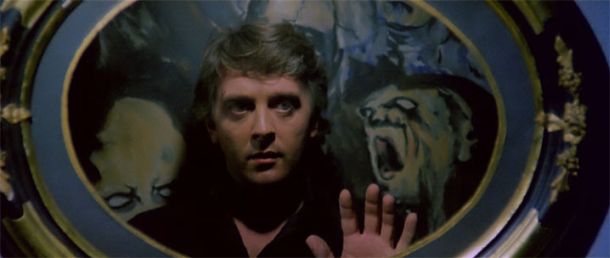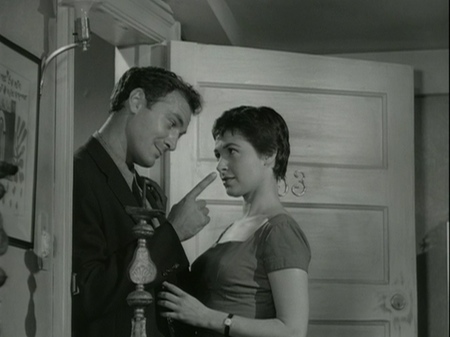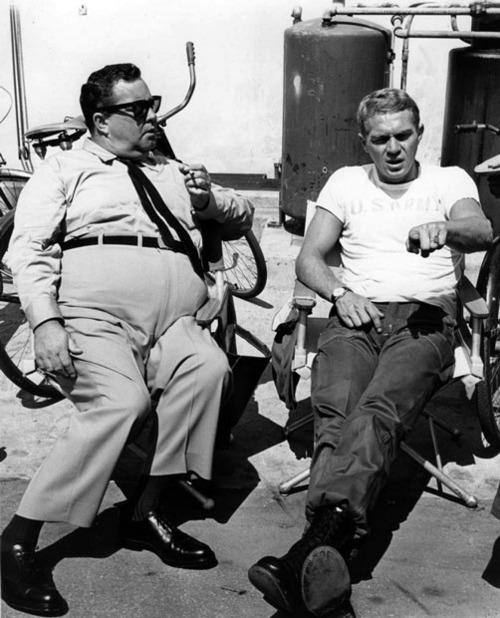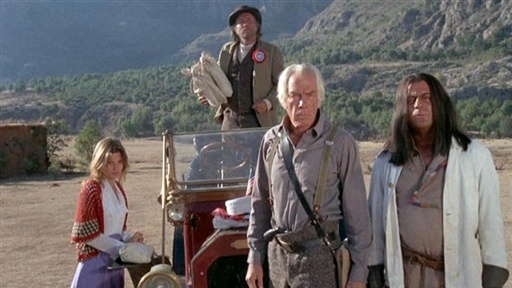
I'm still processing The Tree of Life - still turning over its many ingredients, layers, and moments. The fact that it's been two weeks since the screening and my brain is still stewing means that the film is special and unusual. Yet I don't think I wholly enjoyed Terrence Malick's Palm d'Or-winning sixth feature.
The Tree of Life is everything and nothing - a moving masterpiece and a magisterial mess, gloppy with pretension yet riddled with some of the most jarring and memorable imagery ever committed to film. Good performances and bad dialogue live side by side in Terrence Malick's sixth and most maddening film, as do profound beauty and incoherent editorial choices. The crux of the movie's soulful confusion is that it is both a visionary cosmic statement and an apologia for suburban averageness. The overarching concept here - that religious meaning and spiritual enlightenment can be found on the most unlikely and unexpected city block - is not new, nor is it alien to depiction on film. But the details are divided into two prongs - one that is dramatic and specific, and another that is abstract and impressionistic. In the case of The Tree of Life, this bifurcation is hampered by excessive cutting and, ultimately, a glut of imagery that, despite its high quality, results in a sense of visual over-stimulation and a muddying of the film's thematic waters. Malick's ambition is rare and impressive. But his editorial eye continues to suffer from benign but distracting spasms.
The Tree of Life is a mosaic. Its non-linear narrative is spiked with sequences that somewhat abstractly depict the formation of the solar system and the beginnings of life on earth. The narrative portion of the film (which accounts for the majority of its screen time) concerns the lives of a five-person nuclear family, the O'Briens, who live in the suburbs of west Texas. The close-knit family consists of Mom (Jessica Chastain), Dad (Brad Pitt), and three young boys. The oldest, Jack (Hunter McCracken), is the key figure in the film. A troubled boy, Jack is torn by his love of his parents - the unconditional kind for his mother, and a conflicted love/hate for his domineering but affectionate father.
Pitt's performance is outstanding. His role is wide-ranging and emotional, and the actor brings an authentic sense of character and period to the part. It is a performance of incredible depth and breadth, truly one of the best from any leading Hollywood star in some time. As Mom, Chastain is the object of her son's love and worship - and at the same time a second-class citizen in terms of her dynamic with Pitt's character. Put-upon, and occasionally abused by her husband, Chastain is physically vulnerable and morally inviolate. Pitt's character is very much the opposite - a pillar of physical strength with an occasionally expedient attitude toward morality.
Malick indulges in two of his favorite cinematic devices: a reliance on vague, lyrical voice-over to solidify the film's themes, and a preference for classical music on the soundtrack. Malick's other films, I think, benefit from these devices, whereas The Tree of Life does not. The film's striking imagery and subtle themes don't require the storytelling crutch of narration to sustain them. In fact, the voice-over is distracting rather than additive. On the subject of music, Malick has a well-known knack for nimbly inserting classical pieces in his films that help create an immediate mood and connection to the story: Days of Heaven uses Saint-Saëns' "Aquarium" from The Carnival of the Animals to beautiful and creepy effect, and the opening of The New World features the "Vorspiel" from Wagner's Das Rheingold as the spine-tingling sound of the first meeting between the English and Native Americans. The Tree of Life, on the other hand, feels as if it is cut to the musical selections. At times, there is a feeling that Malick is more interested in creating mini-films around the music than in making a cohesive larger work.
I say that because, in the end, The Tree of Life is not cohesive. It not feel complete. It feels like it is missing pieces here and there, and it feels redundant in other areas. We spend too long milling around in outer space and in the oceans of the early Earth. We spend too long in the O'Brien household, watching the same sets of family dynamics play out over and over again. That Terrence Malick has made a messy film is not a surprise or a disappointment, for Malick's last three films plainly flirt with disaster - they are chunky, disordered, and unpredictable. But The Tree of Life misses the mark because Malick does not seem to have gone far enough in terms of the film's conception: the cosmic inferno and the scenes of early animal life are memorable, but those sequences do not sufficiently interact with the common travails of a single and seemingly isolated family in 1950s west Texas, despite the fact that I enjoyed watching most of what was on the screen - especially the dinosaurs.
The Tree of Life is everything and nothing - a moving masterpiece and a magisterial mess, gloppy with pretension yet riddled with some of the most jarring and memorable imagery ever committed to film. Good performances and bad dialogue live side by side in Terrence Malick's sixth and most maddening film, as do profound beauty and incoherent editorial choices. The crux of the movie's soulful confusion is that it is both a visionary cosmic statement and an apologia for suburban averageness. The overarching concept here - that religious meaning and spiritual enlightenment can be found on the most unlikely and unexpected city block - is not new, nor is it alien to depiction on film. But the details are divided into two prongs - one that is dramatic and specific, and another that is abstract and impressionistic. In the case of The Tree of Life, this bifurcation is hampered by excessive cutting and, ultimately, a glut of imagery that, despite its high quality, results in a sense of visual over-stimulation and a muddying of the film's thematic waters. Malick's ambition is rare and impressive. But his editorial eye continues to suffer from benign but distracting spasms.
The Tree of Life is a mosaic. Its non-linear narrative is spiked with sequences that somewhat abstractly depict the formation of the solar system and the beginnings of life on earth. The narrative portion of the film (which accounts for the majority of its screen time) concerns the lives of a five-person nuclear family, the O'Briens, who live in the suburbs of west Texas. The close-knit family consists of Mom (Jessica Chastain), Dad (Brad Pitt), and three young boys. The oldest, Jack (Hunter McCracken), is the key figure in the film. A troubled boy, Jack is torn by his love of his parents - the unconditional kind for his mother, and a conflicted love/hate for his domineering but affectionate father.
Pitt's performance is outstanding. His role is wide-ranging and emotional, and the actor brings an authentic sense of character and period to the part. It is a performance of incredible depth and breadth, truly one of the best from any leading Hollywood star in some time. As Mom, Chastain is the object of her son's love and worship - and at the same time a second-class citizen in terms of her dynamic with Pitt's character. Put-upon, and occasionally abused by her husband, Chastain is physically vulnerable and morally inviolate. Pitt's character is very much the opposite - a pillar of physical strength with an occasionally expedient attitude toward morality.
Malick indulges in two of his favorite cinematic devices: a reliance on vague, lyrical voice-over to solidify the film's themes, and a preference for classical music on the soundtrack. Malick's other films, I think, benefit from these devices, whereas The Tree of Life does not. The film's striking imagery and subtle themes don't require the storytelling crutch of narration to sustain them. In fact, the voice-over is distracting rather than additive. On the subject of music, Malick has a well-known knack for nimbly inserting classical pieces in his films that help create an immediate mood and connection to the story: Days of Heaven uses Saint-Saëns' "Aquarium" from The Carnival of the Animals to beautiful and creepy effect, and the opening of The New World features the "Vorspiel" from Wagner's Das Rheingold as the spine-tingling sound of the first meeting between the English and Native Americans. The Tree of Life, on the other hand, feels as if it is cut to the musical selections. At times, there is a feeling that Malick is more interested in creating mini-films around the music than in making a cohesive larger work.
I say that because, in the end, The Tree of Life is not cohesive. It not feel complete. It feels like it is missing pieces here and there, and it feels redundant in other areas. We spend too long milling around in outer space and in the oceans of the early Earth. We spend too long in the O'Brien household, watching the same sets of family dynamics play out over and over again. That Terrence Malick has made a messy film is not a surprise or a disappointment, for Malick's last three films plainly flirt with disaster - they are chunky, disordered, and unpredictable. But The Tree of Life misses the mark because Malick does not seem to have gone far enough in terms of the film's conception: the cosmic inferno and the scenes of early animal life are memorable, but those sequences do not sufficiently interact with the common travails of a single and seemingly isolated family in 1950s west Texas, despite the fact that I enjoyed watching most of what was on the screen - especially the dinosaurs.









